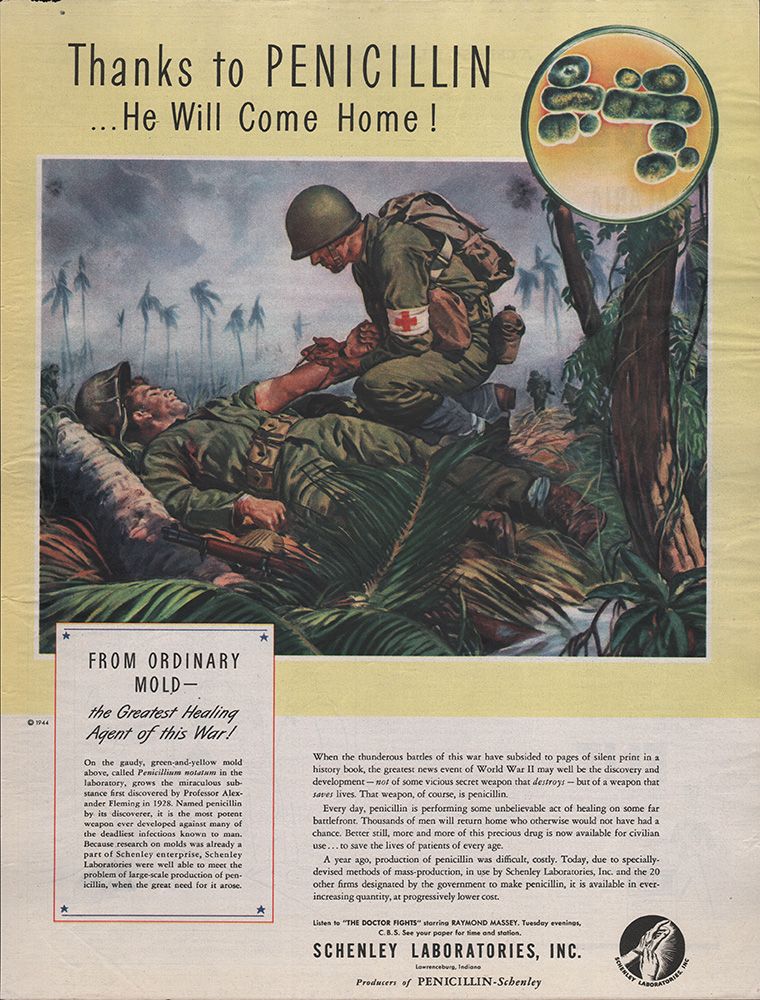
The mighty microbes: White House initiative recognizes the huge impact of tiny bugs
Jo Handelsman noted that the life-saving impact of penicillin, produced by a fungus, changed public views of microscopic organisms during World War II. (Life magazine advertisement from Research and Development Division, Schenley Laboratories, Inc.)
The federal government has assembled a fast-track committee to encourage research into microorganisms, reflecting their increasingly important role in human health and the Earth’s climate.
Jo Handelsman, a Yale microbiologist who is currently associate director for science at the White House Office of Science and Technology Policy (OSTP), described the initiative to science writers attending her CASW New Horizons in Science lecture as part of the ScienceWriters2015 conference at the Massachusetts Institute of Technology. Her message was simple. “Microbes really run the world we live in—every aspect of it,” she said emphatically. “Microbes rule.”
At first overlooked by the scientific community, microbes or microorganisms—a broad group including bacteria and other microscopic, single-celled organisms– have been tied to climate change, human health, and mental illness. Some of the links have surprised Handelsman herself.
Take, for example, our love for chocolate. “People don’t know that when they crave chocolate, one of the reasons is that their microbes (growing within their bodies) are addicted to chocolate. They think that they’re making a human, conscious decision to eat chocolate, but it’s actually the microbes telling them what to do,” Handelsman explained in an interview.
One important finding is that microbes are not loners, but live in complex communities, called microbiomes, virtually everywhere on Earth, from the thin upper atmosphere to deep-sea vents of boiling sulfur. And within us. They grow in massive numbers in and on the human body, outnumbering human cells ten to one.
The government panel assembled by the OSTP is tasked with identifying the most pressing unanswered questions about microbes and microbiomes. What, for example, does a healthy microbiome look like? Which species need to be present, and in what ratio, to produce fertile soil, a healthy intestine or pristine oceans? And if imbalances are detected, how can the microbiome be tweaked?
An aversion to microbes
When Handelsman began her career in microbiology, people were loath to acknowledge that microbiomes even existed.
In her lecture, she described why she thinks scientists were slow to embrace the benefits of microbes. Before the 20th century, microbes conjured images of the bubonic plague and the Irish potato famine in the public psyche. However, the discovery of penicillin, an antibiotic produced by the Penicillium fungus, hinted at the potential benefits of microorganisms.
But further study of microbes was halted by factors both technological and psychological. While Penicillium and other microbes could be grown in petri dishes or test tubes, most species can only survive within the structure of their complex microbiome. Handelsman estimates that only one percent of microbial species, and perhaps far fewer, can be cultured in the lab. Current advances in DNA sequencing technology, which can detect the genetic signature of unculturable species, have led scientists to realize that they are surrounded not by thousands but millions of microbial species.
The second factor that slowed the study of microbes was a lack of imagination. In her talk, the third of the annual Patrusky Lectures established in honor of CASW Director Emeritus Ben Patrusky, Handelsman described a trend in science to shy away from complex theories of nature, instead preferring simpler explanations.
For example, stress or spicy foods were considered as causes of peptic ulcers for a long time. When two Australian scientists suggested that they were instead caused by a bacterial species called Helicobacter pylori, the duo was roundly rejected. To prove their theory, one scientist resorted to drinking a culture of H. pylori to show that it gave him stomach ulcers, and that antibiotics could reverse the symptoms.
The pair would later win a Nobel Prize for their work on stomach ulcers.
Handelsman says she has been drawn to study microbes since grade school, and she can’t help but smile when talking about them. After graduate school, she was treated like “the village idiot” for continuing to study them. Early in her career, she viewed microorganisms as underdogs, and saw her role as a translator, giving a voice to the microscopic but mighty.
“They need more of an interpreter than other organisms or other fields of science where it’s obvious where the magic is,” she explained. “There are very few things in biology that they don’t affect, one way or another, and that has to be interpreted because they’re invisible.”
Policy recognizes the importance of microorganisms
Researchers and policy makers are now embracing her view. When the OSTP formed the fast-track action committee in May of 2015, 14 federal agencies asked to join, a coalition Handelsman described as unusually broad.
Handelsman predicts that more important roles for microbes remain to be discovered. Microbes can consume or produce greenhouse gases, and a strategy addressing climate change would be incomplete without considering them, she says.
Matters of human health are also being shown to have microbial connections. For example, replacing the microbiome of a mouse with that of an obese human causes the mice to show symptoms of obesity. Similar links have been described for asthma, autism, and depression. Researchers are intrigued by the possibility of treating these diseases by focusing on the microbiome.
With the increased attention paid to microorganisms, Handelsman no longer sees them as underdogs in need of a champion. “Now,” she said, “they speak for themselves.”